Diamond Hit – looks like a real Grand Prix stallion
Story – Christopher Hector & Photos – Roz Neave and archives
The German FN breeding values have been in operation in their current form for just on a decade – although they are now divided into three groups based on the estimate of reliability in the most recent, 2011, edition. Perhaps now we can look back at the sires’ rankings and see just how useful they have been in pointing us in the direction of stallions likely to produce superior progeny. Having said that, there is a rather large problem to be overcome first and that is what are our criteria for ‘superior’? Are we looking for horses likely to produce competitors at an international level, or is our real aim to produce the superstars of the young horse classes? We should not scorn the latter aim, since for the breeder it may be a more lucrative market and one that produces results more quickly than the tortuous process of producing an international star.
Don Schufro
A good example is Don Schufro, the stallion that has dominated the dressage standings in the period. From 2002 to 2008, Don Schufro topped the breeding values, dropping to 2nd in 2009 and 2010, before re-emerging with the highest breeding value in 2011, and top place in the group with the highest percentage of reliability (In 2011, the standings appeared in three groups: horses with a reliability estimation of between 70 and 79%; horses with a reliability of 80-89%, and stallions with a reliability of 90-99%)
Don Schufro was a very good Grand Prix competitor himself, although he never really seemed to reach his potential and become a truly great competitor. His best year was 2008 when he won the Danish Championships and was a member of the bronze-medal-winning Danish team at the Beijing Games, where he finished 11th individually. The horse is the classic Donnerhall / Pik Bube cross, with that pedigree and competition record he should be a standout star as a breeding stallion and justify his lofty record on the FN standings… well, not quite.
Despite his popularity with the breeders, not only in Denmark but also in Germany, the result is not what you would call overwhelming. According to the Hanoverian Stallion Book for 2012, Don Schufro has produced 129 competitors (15 at S level) with winnings of €103,611 – the only individual with winnings of more that €10,000 being Donna Asana, who competed Grand Prix with Lone Jörgensen and Evelyn Haim-Swarovski. Former World Young Horse Champion, Donna Unique is now in Patrik Kittel’s barn with Rio de Janeiro hopes but first has to appear in a Grand Prix test…
Diamond Hit
Of Don Schufro’s stallion sons, Diamond Hit went reserve champion young dressage horse and is now competing Grand Prix with Emma Hindle. He was recently 3rd in the Grand Prix Special at Wiesbaden CDI*** and was truly impressive, much more masculine than his sire, and with more scope. He is the sire of Don Diamond, ranked 1st on the FN Dressage Sires list for stallions with an accuracy estimate of between 70 and 79%. Don Schufro’s other much hyped son, Don Romantic had his dressage career cut short by a mystery unsoundness, and while he was proclaimed 2010 Stallion of the Year in Denmark, to date he has produced some nice young horse competitors but nothing of note in the ‘big sport’.
Stakkato
By way of contrast, the Jumping standings have also been dominated by one stallion, the Hanoverian Stakkato (like Don Schufro, born in 1993), who topped the list in 2002 and held that place up to 2011, where he has the highest individual value and also tops the group of stallions with a 90-99% reliability with a breeding value of 169 and a reliability of 98% – only one stallion, Contender has a higher estimated reliability, 99%.
Souvenir by Stakkato – does this remind you of the famous pic of Stakkato at the Bundeschampionate?
According to the Hanoverian Stallion Book 2012, Stakkato has produced 436 competitors (62 at S level) with winnings of €1,210,891, the most successful of which has been Souvenir with €237,235. Another son with winnings of over €100,000, Satisfaction, recently won the World Cup class at Göteborg with Marco Kutscher and is a serious candidate for a place in the German team.
If we look at the top 20 jumping stallions on the 2002 German FN list, it would pretty well do as a breeder’s wish list today: Stakkato, Carthago, Perpignon, Contender, Acorado I, Chambertin, Cassini I, Caretino, C-Indoctro, Coriano, For Pleasure, Escudo I, Capitol I, Concerto II, Levantos II, Lux, Corrado I, Darco, Cambridge, Cornetto.
Really only Perpignon (Pilot / Watzmann) seems out of place, but he did have the second lowest estimate of reliability – 80% – of the 20. Ten years later, Perpignon has produced 76 competitors with winnings of €72,512 (although it should be pointed out, that’s not bad considering he had only 193 registered progeny), and does not make it into the current ‘topliste’ of 45 on the Hanoverian Jumping standings.
It is sometimes argued that the purpose of the breeding values is to draw the breeder’s attention to stallions that might otherwise be neglected, though it seems to me more often that the ‘surprise’ stallions that burst onto the list, disappear after their 15 minutes of fame.
Waterford?
I can remember back when the 2004 FN breeding values were announced being surprised that Waterford (Wolkenstein II / Matcho aa) appeared in 3rd place. The stallion hadn’t done anything (except win his licensing and performance test), hadn’t produced anything except three licensed sons, sons who were never named so presumably did not go on to do a performance test, but they did help boost Waterford’s breeding value, above such important sires as Londonderry, Wolkentanz, Welt Hit I, Rubin-Royal, Donnerhall and Fidermark. The following year, Waterford had slipped to 7th on the standings, next year down to 9th and that year he was exported to the USA. In the 2012 Hanoverian Stallion Book, Waterford is listed with 153 competitors, with winnings of €45,574 – none at S level, but he now has two named sons, Wilkens and Workington. His FN dressage breeding value had decreased from 163 in 2005 to 140 in 2012, while his Hanoverian dressage index had also dropped from 148 to 131 in the same time. His licensed full-brother, now gelded, is struggling on the international scene as a member of the Finnish dressage team and finished second last in the Grand Prix at the Europeans in Rotterdam.
Waterford – how soon the bubble burst!
It is interesting to see just which stallions from the 2002 list have stayed the journey. Looking at the 2011 rankings and the 90-99% senior list: Don Schufro is of course still there, as is Wolkentanz (down =2nd to 19th), Fidermark (=2nd to =29th), Welt Hit I0 (5th to =17th), Don Primero (6th to =11th), Donnerhall (=6th to =20th), Weltmeyer (=10th to =27th), Wie Weltmeyer (14th to =32nd), Hohenstein (=16th to =38th), Florestan (=21st to =29th).
There are a few anomalies – like De Niro, 10th on the 2002 list, nowhere in 2011, although three of his sons feature: Dancier (3rd), Danone I (=28) and Desperados ( =29th). Three of his sons make the 80-89% list: Donautanz (=11th), Danzas (=31st) and Denkeas (=38th). Another son, Danone II is =11th on the 70 to 79% list, and there are a number of De Niro grand-sons who make the lists. Odd…
Predictions…
Of the top ten, I’ll make the prediction (let’s check it ten years hence), that the Sandro Hit son, Sancisco will disappear without trace, and I have serious doubts about the long term viability of a couple of the other stallions in the ten: Dancing Dynamite (4th), Dancier (5th), Lord Loxley (7th) and Dr Jackson D (8th) and I guess the debate over Sir Donnerhall (2nd) will continue to rage, as it did about his sire Sandro Hit, who has never made into the top ranks of the breeding values – despite the fact that numerous sons, and grand-sons appear. On the three 2011 lists we find four Sandro Hit sons on the 70-79% standings, five in the group with a reliability of 80 to 89%, and four more in the 90-99% standings. Odd again…
Looking at the senior (90-99%) Jumping Standings, it is remarkable how unaffected by the fluctuations of fashion the jumping scene is. Not only is Stakkato still number 1 (joined by his son, Stolzenburg in =5th), Carthago has moved just one place from 2nd to 3rd, while Contender has dropped from =3rd to =13th but his son, Contendro I has taken 4th slot and another son, Concerto II is =5th. Chambertin has dropped from =3rd to =34th but his son, one of the current rising stars, Chacco-Blue is up there at number 12. Cassini I was ranked =3rd in 2002, in 2011, he is =8th. Caretino moves from =3rd to 11th.
New faces at the top include the second ranked Cornet Obolensky (his sire the Dutch based Clinton – by Corrado I – is not to be confused with the German-based Clinton – Carolus / Calypso II – who shot up to 2nd on the 2006 list, but by 2011, was down in =17th on the stallions with a reliability of 80-89%, although he is in good company, the other stallions ranked 17th on that list include Darco, and the ‘other’ Clinton).
Catoki, by Cambridge, is another newcomer, he first appeared in 2007 when he rocketed into second place after not appearing in the top 20 of 2006. At the time I commented “how on earth is it that the eight-year-old Catoki whose claim to performance fame consists of some good Bundeschampionate performances and a win at the Rastede Grand Prix, and whose output to date consists of some promising foals and two licensed stallions, rate above Carthago, Clinton, Indoctro and Cassini??”
His Highness – was he too highly rated?
I had also questioned the ranking of another young sire, with no progeny to speak of, His Highness, in 4th place on the dressage rankings. My good friend Ludwig Christmann of the Hanoverian Verband gently took me to task for my breeding values ‘polemic’. He pointed out that “while His Highness has a few more points in the evaluation than Donnerhall, you cannot say that automatically one is a better sire than the other one. Both stallions have breeding values in the FN rating of more than 150 points. This means, that they are more than two and a half standard deviations above average, which groups them probably in the top 2/3% of our stallions. And there is an evaluation of the characteristics that make up this evaluation – in both our Hanoverian breeding evaluation, and in the FN’s Jahrbuch Zucht, you can find detailed evaluations of head, neck, frame and so, as well as individual scores for walk, trot and canter. So the breeder can find objective information which would help him to find the stallion that best matches his mare. Especially in times when many breeders rely on glossy coloured photos and videos composed by the stallion owner, the breeding evaluations are an important tool for the mare owner. That does not mean that the system is perfect, but we are able to improve this system by publishing the breeding values. This is the best way to find the weak spots.”
“You also mentioned Catoki and this is another good example. He is well bred, he has been very successful with his own performances and his first offspring were outstanding… So he deserves a high breeding value. Because the evaluation is based on a limited number of offspring, the breeder can see that the reliability of this value is not high, which indicates that this may change in the future, but it is a hint to the breeder: Here is a young stallion which deserves further attention.”
Five years later I remain unconvinced.
His Highness (who died in 2007 but whose frozen semen kept him in the stallion market for some years after that, and who in his first couple of seasons bred more mares than most stallions cover in a lifetime) has slipped to 25th on the Hanoverian rankings, having produced 242 competition horses out of the 665 registered in the Hanoverian book, for winnings of €69,524, including two S level dressage horses, and four licensed stallions, none of whom have set the world on fire. His FN dressage breeding value has gone from 166 in 2007 to 147 in 2012, while his Hanoverian dressage score has similarly taken a battering: 151 to 134.
And Catoki? Catoki has been a good competitor with Philip Weishaupt, winning Grand Prix in Vigo and Bordeaux in 2011, and he is still up there on the FN rankings in equal 5th. However, while he has produced finalists at the Bundeschampionate, 19 (!) licensed stallion sons and some very expensive auction foals, his jumpers have had at the best moderate success in the ‘big sport’.
The other ‘odd man out’ in the 2011 90-99% top ten is Cellestial, a son of Cantus. Cellestial himself had a successful competition career, mainly in partnership with Rolf-Göran Bengtsson, placing second in the CSW-W in Amsterdam in 2005. He retired after the 2006 season and since then, has produced some very normal performers, the best of who seems to be Heiko Schmidt’s Cassiopeia, third in a 1.50m class at Redefin CSI**. Now it may be that ‘the numbers’ have unearthed an otherwise neglected star, but I’ll let the expert who produced this result send his good jumping mare to Cellestial – I’ll take any of the following: Caretino, Chacco-Blue, Cento, Capitol, Calido and For Pleasure – the horses listed immediately below Cellestial on the rankings.
Celesta by Cellestial
I feel looking at the standings over ten years, that they bear out the observation of that great Dutch breeder, Jan Greve: “the numbers tell us what we already know”, except in the case when they tell us something surprising, and then they are usually wrong. It is perhaps lucky that the mare owners in Germany, like their neighbours in Holland, have cheerfully ignored ‘the numbers’, consistently sending their mares to stallions with low breeding values, or in the case of the fashionable young stallions, no breeding values at all, while the highly ranked stallions receive very few visitors.
The breeding values will continue to provide employment to hard working statisticians, and fodder for journalists to write about, but are they really the aid to the breeder they were meant to be?

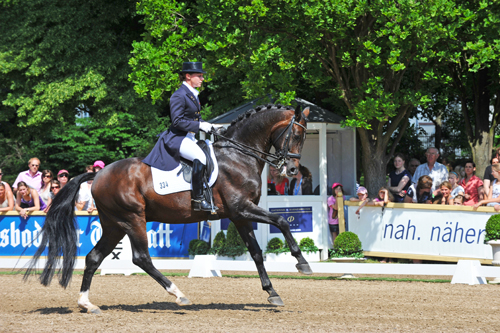
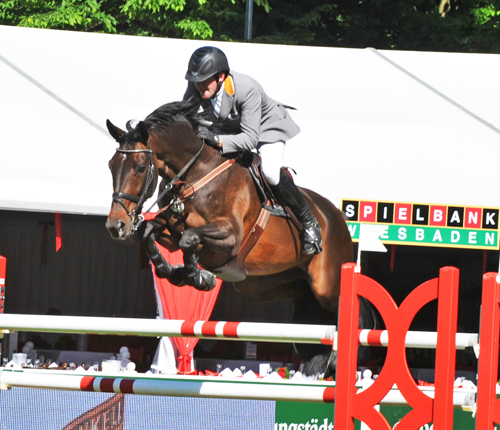
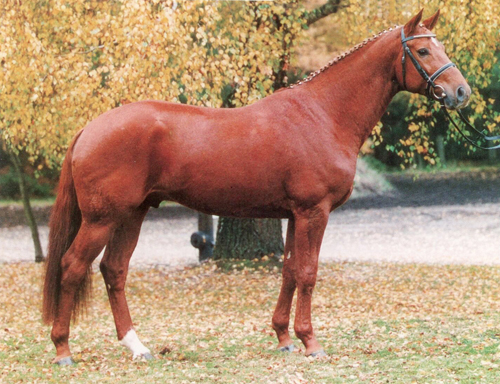
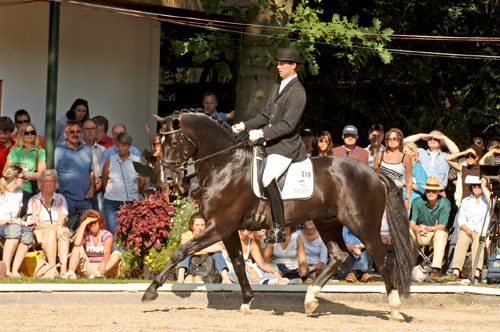
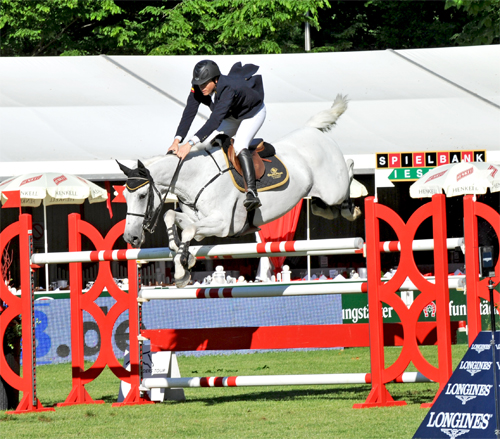
Wonderful article Chris and Roz! Reading it I feel like I am in a conversation with you again 🙂
What a nasty little article! To single out Waterford for harassment was small and unprofessional.
His full brother was a Grand Prix horse competing on the Finnish Olympic team. That he finished near the bottom a particular meet is beside the point, he was a competing Grand Prix horse. First time I ever read an article where a horse competing at Grand Prix, the author tried to make that sound like a bad thing and put a negative spin on it.
Having just had a mare bred to Waterford, I will be remembering Chris and Roz come Yuletide, and pray that Santa leaves a big lump of coal in their stocking.